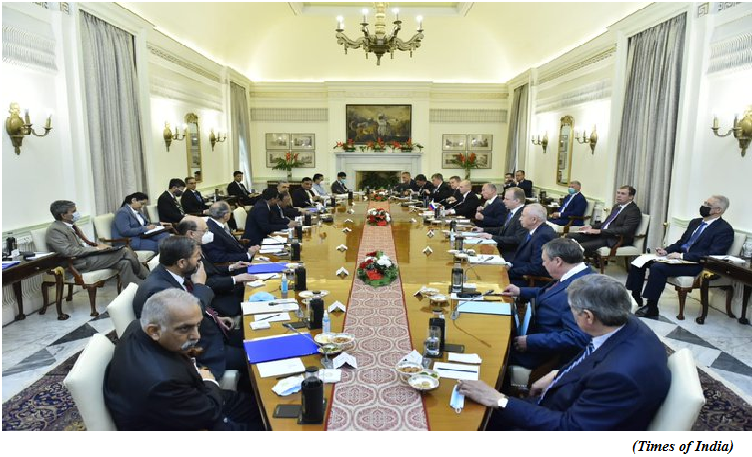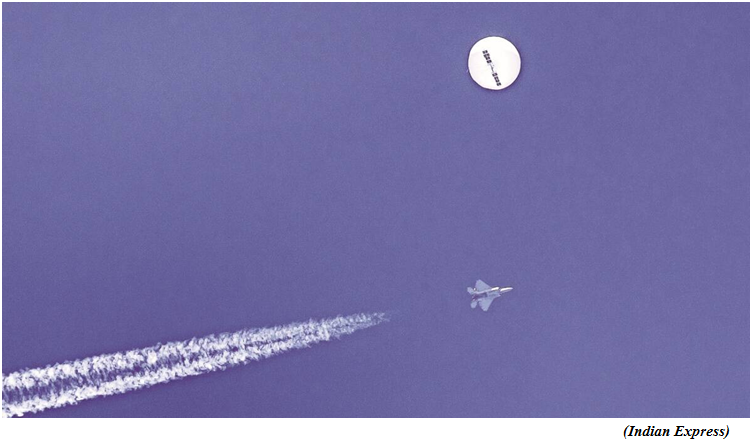India holds conference of global intelligence chiefs (GS Paper 3, Internal Security)

Why in news?
- Amid the G-20 Foreign Ministers’ Meeting and ahead of the Raisina Dialogue, India quietly held the second conference of intelligence and security chiefs and top officials from around the world, called the Raisina Security Dialogue, on March 1 which saw participation from over 26 countries.
Details:
- India is trying to make its presence felt in bringing together global intelligence agencies for exchanges on issues of common concern.
- The focus of the discussions was largely on global security which encompassed counterterrorism, radicalisation, drugs trafficking, and illegal arms smuggling, among others.
- Prime Minister Modi and National Security Adviser addressed the conference, which is modelled on the lines of the Munich Security Conference, the 59th edition of which took place from February 17 to 19, and Singapore’s Shangri-La Dialogue.
Conducted by R&AW:
- The security conference is organised by the country’s external intelligence agency, the Research and Analysis Wing (R&AW) and the National Security Council Secretariat (NSCS) that reports to National Security Adviser.
- The conference was held for the first time in April 2022, a day before the start of Raisina Dialogue,India’s flagship conference on “geopolitics and geo-strategy” organised by the Ministry of External Affairs (MEA) in collaboration with Observer Research Foundation (ORF). The eighth edition 2023 was held from March 2-4.
Background:
- The conference comes a year after the war in Ukraine that is still ongoing and the global attention fixed on it,while India has been flagging other global issuesincluding Afghanistan.
- Deep differences over Ukrainebetween the U.S.-led Western countries and the Russia-China combine thwarted India’s attempts to bring out a joint statement at the G-20 Foreign Ministers’ Meeting.
Govt putting in place protocols to tackle threat of spy balloons after Andamans incident
(GS Paper 3, Internal Security)
Why in news?
- Recently, the Indian military has drafted a set of basic protocols to tackle newer threats like surveillance balloons or other unidentified objects in the sky after a similar entity was spotted a year ago over the strategic Andaman and Nicobar Islands.

Details:
- The protocols detail the sequence of action in case an unidentified slow-moving aerial object is spotted. This includes detection, positive identification, verification and targeting using a suitable platform and weapon system, followed by detailed photography of the target, a comprehensive report on it and analysis of remnants, if recovered.
- The set of tri-service protocols being put in place will be open to upgradation. Already, several radars are being upgraded at key military installations.
Spy balloon in US:
- In February, the United States shot down a giant Chinese balloon, which it accused of spying on its crucial military sites, with an AIM-9X Sidewinder missile fired from an F-22 fighter jet.
- China denied the allegations and said it was a civilian aircraft meant to research weather-related aspects.
- Days later, the US shot down a cylindrical-shaped object over Canada and another unidentified aerial object in its own airspace.
Why India issued a protocol?
- India’s protocols were drafted after an aerial object was spotted over the Andamans, even though its origin could not be ascertained at that time. The object had drifted away over the ocean before military authorities could take a decision on action to be taken.
- As per the standard operating procedure, positive identification of the aerial object and subsequent verification to rule out the possibility of it being a civil asset will be the first steps when such a flying object is spotted.
- Once identified and verified, a decision will be taken to destroy the target. The weapon systems, such as missiles or a ground-based air defence system, and the aircraft deployed will be selected based on the altitude of the target.
Strategic importance of Andaman and Nicobar Islands:
- The Andaman and Nicobar Islands house the tri-service Andaman and Nicobar military command. What makes these islands strategically important is their proximity to the Indo-Pacific as well as to major choke-points or sea lines of communication (SLOC) in the Bay of Bengal — the Malacca Strait, Sunda Strait, Lombok Strait and the Ombai-Wetar straits.
- Most of the world’s shipping trade passes through these choke-points.
- The islands offer India the potential to play a critical role towards enhancing its influence in the Indian Ocean region and support its military operations in the area.
Nations secure pact to protect marine life in the high seas
(GS Paper 3, Environment)
Why in news?
- For the first time, United Nations (UN) members have agreed on a unified treaty to protect biodiversity in the high seas. The treaty agreement concluded in New York.
- An updated framework to protect marine life in the regions outside national boundary waters, known as the high seas, had been in discussions for more than 20 years, but previous efforts to reach an agreement had repeatedly stalled

Why it matters?
- The ocean supplies half the planet’s oxygen, absorbs more than a third of carbon dioxide emissions from the burning of fossil fuels and feeds billions of people.
- If ratified, the UN high seas biodiversity treaty could build in new hurdles for corporations operating on the high seas; defined as the 60% of the ocean beyond any nation’s jurisdiction including for those companies proposing to remove carbon dioxide from the ocean.
Key Highlights:
- The treaty does not regulate overfishing, a prime threat to ocean biodiversity, as fishing in international waters is managed by other organizations. But it does allow for the establishment of marine protected areas on the high seas, where fishing could be banned. That would enable the UN to move toward a target of conserving 30% of the ocean by 2030.
- The treaty also requires environmental impact assessments for potentially harmful activities, such as proposals to conduct geoengineering experiments in the ocean to combat climate change.
- Another main provision requires sharing with all nations any bounty from harvesting marine genetic resources, which includes marine molecules, bacteria and algae that could be used in pharmaceuticals and other products. The treaty also provides for the transfer of marine technology to developing countries.
Shortcomings in UNCLOS:
- Disputes over those issues, particularly the sharing of marine genetic resources, had stymied treaty talks since 2018, when negotiations were authorized to draft a legally binding high seas biodiversity treaty under the UN Convention of the Law of the Sea (UNCLOS). That 1982 agreement regulates activities in international waters, including seabed mining.
- But the word “biodiversity” does not appear in UNCLOS, nor does the agreement provide any mechanisms to assess the environmental impact of industrial activities on ocean life or provide for its conservation through marine protected areas. The drafting of a high seas biodiversity treaty has been a decades-long effort to resolve those deficiencies.
What’s next?
- Delegates will reconvene at a later date to formally adopt the text of the treaty, which will then go to the UN General Assembly for approval.
- After the UN General Assembly approves the treaty, 60 nations must ratify the agreement for it to go into effect. The US has never ratified UNCLOS due to opposition from the Republican Party, but the Biden administration has supported the high seas biodiversity treaty.




